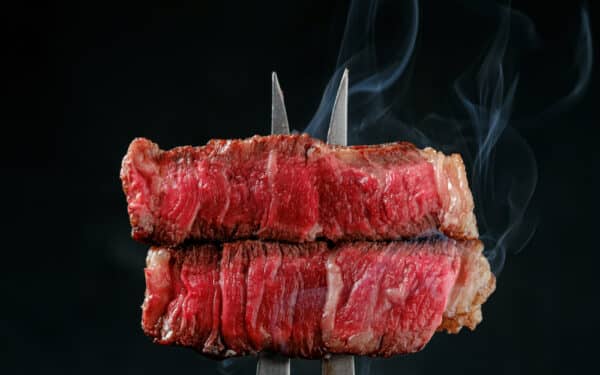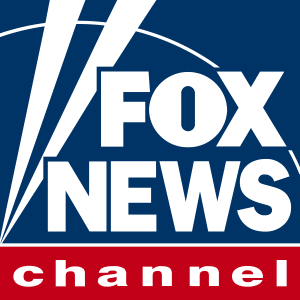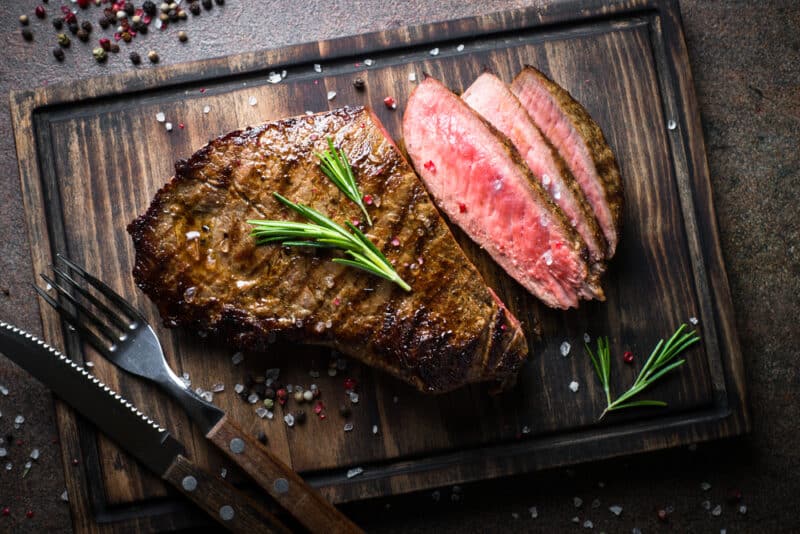How to Cook Frozen Steak on the Grill (3 Quick Steps)
TheGrillingMaster.com is reader-supported. If you buy something using the links on our site, we might earn an affiliate commission at no added cost to you. This helps us pay our staff to keep making awesome content for you!

Grilling is an excellent way to cook a steak for a delicious meal. However, many people don’t realize that it’s also possible to cook a steak that is still frozen.
Grilling a frozen steak can be tricky, and requires a few special steps to ensure that it cooks properly.
In this article, we’ll look at why grilling frozen steak is possible, and provide step-by-step instructions on how to do it correctly.
With the right approach, grilling a frozen steak can result in a juicy, flavorful steak that is sure to satisfy any steak lover.
Related Reading >> How to Grill Frozen Burgers
Reasons for Grilling Frozen Steak?
Our hectic lives usually mess up our meal prep, especially on weeknights.
Grilling is a great way to get a meal ready in no time, even if you didn’t remember to take the meat out of the freezer or don’t have a plan for dinner.
Plus, if you unexpectedly get visitors, this is a great meal to put together fast. It may sound weird to put a piece of solid frozen meat on a super-hot grill, but it really works.

Freezer loaded with frozen meat
Here’s another reason for cooking frozen steak.
When you put a frozen steak on the grill, just the outside will get seared.
Since the meat is so cold, it needs a lot of heat energy to start cooking, so overcooking is less likely.
Only the top layer of the steak will be cooked. Think of it as a “thermal shield” that helps keep the inside of the steak cooler, so it stays juicy.
If you put a frozen steak on the direct heat of a grill, the protein fibers in the exposed layer of the meat start to shrink and tighten, squeezing out their water and drying up. Therefore, only the surface is caramelized.

Thick Prime Rib Steaks
This usually gives the meat a brown or gray color, known as a gray band. But if you sear the steak properly, the inside will warm up slowly, meaning there won’t be a gray band and the steak will be more evenly pink.
This means it won’t be overcooked and will be juicier to eat.
Select the Best Steaks for Grilling
If you’re into grilling, especially beef, the type of cut you get makes a huge difference. A rib eye is a great place to start, as it has the most fat and flavor. Filet Mignon is super lean, so the more fat in your steak, the better.
We will discuss grades shortly, but first, let’s look at the common brands of high-quality beef.
Wagyu
The Wagyu is a Japanese cattle breed that’s well-known for its marbling, and within that family is the famous Kobe beef.

Wagyu Steak
Angus
Angus is a popular brand of Certified Angus Beef that comes from American ranches, but it’s usually much more affordable than Wagyu.

Black Angus Steak
How to Get Consistent Beef Flavor
If you want to be the top griller of beef cuts, you need to be consistent.
What the animals eat can make a difference to the flavor of the beef, so check out where your meat is from – is it grass-fed, grain-fed, or from open pasture?
Grass-fed beef
Grass-fed beef typically has a yellowish hue in its fat, whereas grain-fed beef typically has more white fat.
The beef is more unique, changing flavors day to day because the fat is created from different grasses and pastures. This variety of flavors gives grass-fed beef its unique taste.
Grain-fed beef
Grain-fed beef has a predictable flavor, so you know what to expect every time you buy it.
It’s great when you cook frozen steaks because you’ll get the same taste every time.
What are the Best Quality Grades for Beef?
The beef has been checked over and sorted into categories to make it simpler for you to pick what you want, depending on what you like and how much you can spend.
There are up to eight grades of beef, but most stores will have Select, Choice, and Prime.
- Select – The leanest grade, tough texture, not much marbling, and it is the cheapest option.
- Choice – Fattier than select, but it has less marbling than prime, a coarse texture, and it is slightly cheaper than prime.
- Prime – Top-notch grade, juicy, flavorful, and lots of marbling. It is pricier than the other grades, but worth it.
Choose Thick Steaks for Grilling Frozen Steak
Thinking you might want to get a thinner frozen steak, so it cooks faster. Think again! A thicker steak is the way to go for the best flavor.

Thick, frozen T-Bone Steak
That’s because the steak has to be heated up to a really high temp (350°F) for the Maillard reaction (a chemical process that creates the browning and flavor) to take place. The frozen steaks start off at 32°F, so it’ll take a bit of time to reach 350°F.
Thin steaks don’t thaw as slowly as thick ones, and they get overcooked and dry before the outside can get hot enough to activate the Maillard reaction. So, it’s best to go with a thicker cut of steak if you can – that way you can get the exact doneness you’re looking for.
This technique works best for steaks that are between one and one and a half inches thick. I don’t suggest cooking frozen steaks that are thinner, like skirt or flank, unless you or your guests prefer their steaks well-done because the inside could get too cooked before the outside is browned. Sirloin steak is sort of on the border between thick enough and too thin.
The following cuts are best for frozen steak grilling.
- Rib Eye steak
- New York Strip steak
- Porterhouse steak
- T-Bone steak
- Filet Mignon
- Picanha steak
- Flat Iron steak
- Hanger steak
Steaks must be Properly Frozen
To get the best results when grilling frozen steak, make sure each steak has a flat surface that is as even as you can get it. The entire surface of each steak should be touching the cooking surface at the same time, so the heat is spread evenly, and it cooks through properly.
Here’s how I tackle this 2-part freezing process:
Part one
- Remove the steaks from their packaging and use a paper towel to pat them dry.
- Place the steaks on a sheet of parchment paper in a flat baking pan or cookie sheet.
- Make sure each steak is lying perfectly flat.
- Place the tray into the freezer, uncovered to allow the air in the freezer to cause the evaporation of any moisture on the meat.
- This will improve the sear when you put the steaks on the high-heat zone of the grill.
Part two
- Leave the steaks on the tray overnight, or check after about 5 hours. If they are solidly frozen, go ahead and package them.
- Wrap each steak tightly with plastic wrap, and then store them in Zip Lock or other well-sealed plastic freezer bags.
- You can use freezer paper instead of plastic wrap.
- The wrapping method you use must ensure the meat is securely sealed away from any air that can cause icicles, frost, or freezer burn.

Thick, flat-surface, frozen New York Strip Steak
Follow these steps, and you can keep your steaks frozen for up to six months.
You need to watch out for freezer burn if you want to get your steaks from the freezer to the griller, and to your plate in less than 30 minutes.
Don’t leave them open in the freezer for too long, or you might end up disappointed. As long as you wrap them up properly, frozen meat will keep from getting freezer burn for 3 to 6 months in your regular home freezer.
Related Reading >> How Long Does Prime Rib Last in the Fridge?
How to Prepare the Grill
Here’s the most important step to grilling frozen steaks:
Create two sections on your BBQ grill: one with direct heat and one with indirect heat.
The direct heat side should be around 500-700°F, but be aware that grease flare-ups can be really hot, up to 2,500-3,000 degrees Fahrenheit.
The indirect heat side should be much more moderate, around 300-350°F, and it should be located at least six inches away from the intense heat zone.
If you’re using a pellet or a charcoal grill, focus most of the fire source in the high-heat zone.
If you’re using a gas grill, fire at full power on one side, and low power on the other side.
You wanna preheat the grill, so you can hit the steak with direct heat on the grill to get a good sear and a nice crust.
Then, move it over to the indirect heat area to cook the middle of the steak.
You’ll need high heat to start and lower heat to finish cooking it to your desired doneness.
Related reading: How to reheat steak.
How to Grill Frozen Steaks
The process of grilling frozen steaks involves three steps – Searing, Seasoning, and Cooking.
The direct heat side temperature should be 500°F or higher, and the indirect heat side should be at 325°F to 350°F.
1. Searing
- Remove the steaks from the freezer. If there is any sign of moisture, use a paper towel to pat it dry. Removing as much moisture as possible from the steak’s exterior allows the steak to form a delicious, caramelized crust.
- Place the frozen steaks on the direct heat side grill grate of the 2-zone grill set-up.
- Sear the steaks for about 5 minutes on each side, making sure they are caramelized to a deep brown color with dark grill marks all over. The searing will give the edges a delicious, crispy texture.
- Keep a watchful eye on your steaks and make sure not to leave them on the open flame for too long, and be on the lookout for flares.
- Ideally, you want to monitor the steaks’ internal temperature with a meat thermometer.
- At the end of the sear, the internal temperature should be at 75°F to 90°F. Each side of your meat should have a beautiful crust seared onto it.

Grilling Phase 1 – Searing Steak
2. Seasoning
- No matter how much you try, you won’t get seasoning to stick to your frozen meat, so it’s best to do it after you’ve seared it.
- Give both sides a good sprinkle of salt and pepper, and if you’re feelin’ adventurous, you can add some other herbs and spices, but I prefer to just keep it basic with salt and pepper to enhance the rich beef flavors.
- Go for kosher salt if you can, since it sticks to food better, and melts faster than regular table salt. I use kosher salt and pepper, a 2:1 ratio.
3. Cooking Frozen Steak – Phase 2
- Now’s the time to get your steaks cooked through to the perfect temp on the interior of the steak.
- After you season it, place the meat again on the grill, this time on the indirect-heat side of the grill. It should be cooked for about 10 more minutes, depending on the desired doneness.
Pro Tip: You can also smoke your steak if you want to try a new method! See our guide.

Cooking Phase 2 – Steak in Low-Heat Zone
Internal Temps and Colors for Steaks |
||
Doneness |
Inside Color |
Final Temperature |
|
Rare |
Bright Red |
125°F to 130°F |
|
Medium-Rare |
Red |
130°F to 135°F |
|
Medium |
Pink |
135°F to 140°F |
|
Medium-Well |
Slightly Pink – Mostly Gray/Brown |
140°F to 150°F |
|
Well |
No Pink – All Brown |
155°F + |

Doneness of Steak at different Internal Temperatures
Monitor the Internal Temperature
If you’re not familiar with the timing for cooking a steak, the best way to tell if it’s done is to use an instant-read thermometer.
You want to avoid serving something that’s too raw or still frozen in the center.
Nor do you want to serve overcooked steak.
And, don’t be tempted to cut into it to check if it’s ready before it’s done, or all your hard work will be ruined.
Use the table below to know precisely when to pull the steaks.
The inside of the steak will take its time getting to the temperature you want it to be, so keep checking it to make sure it’s cooked just the way you like a perfect steak.
Remember to cook it to a “pull temperature” which is 5 degrees lower than the final temperature you want it to be, as it will heat up another 5 degrees while it’s resting.
Related reading >> Can You Eat Raw Steak?
Internal Temperatures for Perfect Steaks |
||
Doneness |
Pull Temperature |
Final Temperature |
|
Rare |
120°F to 125°F |
125°F to 130°F |
|
Medium-Rare |
125°F to 130°F |
130°F to 135°F |
|
Medium |
130°F to 135°F |
135°F to 140°F |
|
Medium-Well |
135°F to 140°F |
140°F to 150°F |
|
Well |
150°F + |
155°F + |

Rare Steak
Why is it Important to Let the Steaks Rest?
Grill the steak to your desired temperature, but take it off the grill when it’s 5 degrees Fahrenheit lower because the temperature will continue to rise while it rests.
This is called carryover cooking. Let it rest for at least 5 to 10 minutes before you slice it. This lets the fibers relax and the juices spread throughout the steak.
Don’t cook it beyond medium if you want it to be tender and juicy.
My favorite is medium-rare because it is especially juicy and flavorful.
If the steak is frozen, it’ll take longer to cook – about 22 to 25 minutes for a 2-inch-thick steak to reach medium-rare with an internal temp of 135°F.

Voilà! From Frozen to Masterpiece in less than 30 minutes!
Frequently Asked Questions about Grilling Frozen Steak?
Q: Can I put a frozen steak on the grill?
A: Yeah, sure! You’ll have to change your cooking style, and it’ll take longer, but it’s totally doable. You’ll still get a juicy, tender steak with a nice crunchy crust. Believe it or not, cooking from frozen might even give you better results.
Q: How long does it take to grill a frozen steak?
A: The cook time to grill frozen steak is around half an hour, which gives you a great crust on the outside while still keeping the inside juicy and undercooked.
Q: How do you grill frozen steak without thawing it?
A: Take the steaks straight from the freezer and put them on the hot side of the grill. Cook for about 5 to 7 minutes on each side, then move them to the cooler side to finish off to your desired temperature.
Q: Can you marinate frozen steaks?
A: No, leaving steak in a marinade will change it into a thawed steak, ruling out grilling frozen steak.
Q: Can I season frozen steak?
A: No, the seasoning will not stick to a frozen piece of meat. The best way is to season the steak after searing and before the indirect cooking period.
Q: How can I do two-zone grilling on a gas grill?
A: If you’re using a gas grill, that means turning the fire high on one side and keeping the burners low on the other side.
Q: How long can I keep steaks in the freezer?
A: If you seal it properly to avoid any air exposure, you can keep frozen steaks for up to 6 months in a typical household deep freeze.
Q: Why are thick-cut steaks best for frozen grilling?
A: The intense heat required for the sear will overcook thin steaks like flank or skirt steaks.
Learn More About Grilling
If you want to learn more about grilling, check out these other helpful resources!

Kevin Turner
Hi there, I'm Kevin Turner, Founder and CEO of thegrillingmaster.com. I started this website to share my passion and knowledge with you. You can leverage my years of experience as a pit master and professional to grill great food!
About The Grilling Master
Hi there, I'm Kevin Turner, Founder and CEO of thegrillingmaster.com.
My passion has always been grilling, smoking and BBQ delicious meats that satisfy my inner carnivore!
I started this website to share my passion and knowledge with you, the hungry reader who wants to prepare the perfect meal.
You can leverage my years of experience as a pit master and professional.
Send me a message and let's connect on Twitter here.

















